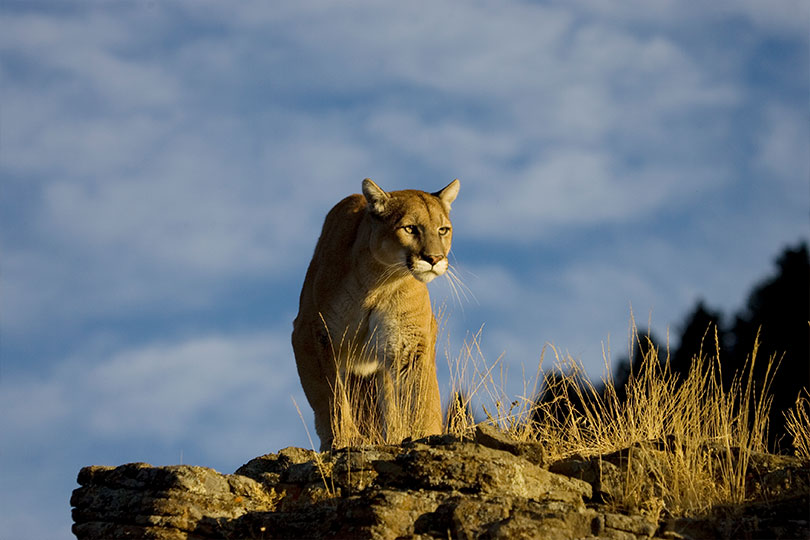In the rugged terrain of Big Bend National Park, a hiker felt a piercing gaze from a distance. This silent observer, embodying the spirit of the wild, mirrored the hiker’s movements before vanishing into the wilderness, leaving behind a sense of wonder and respect. It was a mountain lion. You’ve likely heard many stories like this or perhaps have some of your own. The mountain lion, often referred to as a “Ghost Cat,” is Texas’ most elusive and enigmatic predator. These majestic creatures, often shrouded in mystery and folklore, are an integral part of the state’s rich natural history and often at the forefront of Texas landowners’ minds. But what makes them so elusive? And how can we live in harmony – not fear them?
What Makes the Mountain Lion so Elusive to Texans?
The elusive nature of the mountain lion, a master of stealth and shadow in the Texas wilderness, makes gathering concrete data on their population and behaviors a challenging task. Their secretive and nocturnal lifestyle only adds to the mystique surrounding these majestic creatures.
- Solitary and Stealthy: Mountain lions lead solitary lives and their hunting techniques are stealthy, allowing them to move undetected through the wilderness.
- Masters of the Night: Their nocturnal and crepuscular habits mean they are most active when visibility is low, further reducing the chances of human encounters.
- Adapted to Avoidance: Naturally wary of humans, mountain lions go to great lengths to avoid contact, preferring the solitude of remote and rugged terrains.
Mountain Lion Ecology in Texas
Delving into the ecology of these creatures, we find their presence spread across various regions of Texas, each adapting uniquely to its environment.
- Geographical Distribution: Mountain lions are found in several regions across Texas, with higher concentrations in the Trans-Pecos region, the South Texas brush country, and the Hill Country. They are less common in East Texas and the Panhandle.
- Habitat Range: Individual mountain lions can have a large territory range, especially males. A male’s territory can span over 100 square miles, while females typically have smaller ranges. This territorial nature affects their density in any given area.
- Diet and Prey: In Texas, mountain lions primarily prey on white-tailed deer, although they also hunt feral hogs, javelinas, and other small mammals. The availability of prey can influence local mountain lion populations.
- Mortality and Threats: Human-related causes, including vehicle collisions and hunting/trapping are significant mortality factors for mountain lions in Texas. Natural causes of death include territorial disputes, especially among males.
- Reproduction: Female mountain lions typically give birth to a litter of two to three cubs every two to three years. Cub survival rates and reproductive rates can impact population dynamics.
Perception vs. Reality: Living with Mountain Lions
The myth often overshadows the reality when it comes to mountain lions. Understanding their true nature can alleviate many unfounded fears.
- Avoidance: Contrary to popular belief, mountain lions are not a direct threat to land, property, or humans. They naturally avoid human contact.
- Protecting Livestock or Pets: A primary concern for landowners is the potential for mountain lions to prey on livestock or pets. While mountain lions primarily hunt wild prey like deer, they may occasionally target domestic animals, especially in areas where their natural prey is scarce.
- Wildlife & Game Management: In areas with active mountain lion populations, landowners might need to engage in additional management practices to coexist with these animals, such as securing livestock, using wildlife-friendly fencing, and implementing other deterrent measures.
- Behavioral Awareness: During the mating season (winter to early spring) and cub-rearing season (spring and summer), mountain lions exhibit increased activity and protectiveness, respectively. It’s important to be vigilant and make noise to avoid surprise encounters, and if faced with a mountain lion, maintain eye contact, appear larger, and back away slowly.
Mountain Lion Tracking and Research
Despite their elusiveness, modern technology and citizen science are shedding light on the lives of these ghost cats.
- Research Techniques: GPS collaring and camera traps are providing crucial data on their movements and health, informing conservation strategies and aiding in the mitigation of human-wildlife conflicts.
- Citizen Science: Tools and apps like the Wildlife Observer Network, Project Noah, and NatureServe Explorer enable you to contribute your sightings, playing a vital role in ongoing research and conservation efforts.
The mountain lion, a quintessential symbol of the wild, continues to captivate and intrigue us. As we strive to understand these magnificent creatures, we must also recognize our role in their conservation. By embracing coexistence, supporting research, and dispelling myths, we can ensure that mountain lions remain a vital part of Texas’s natural legacy. Share your stories, participate in conservation efforts, and help us keep the spirit of the Texas wilderness alive.









